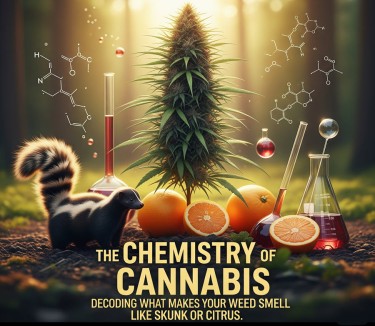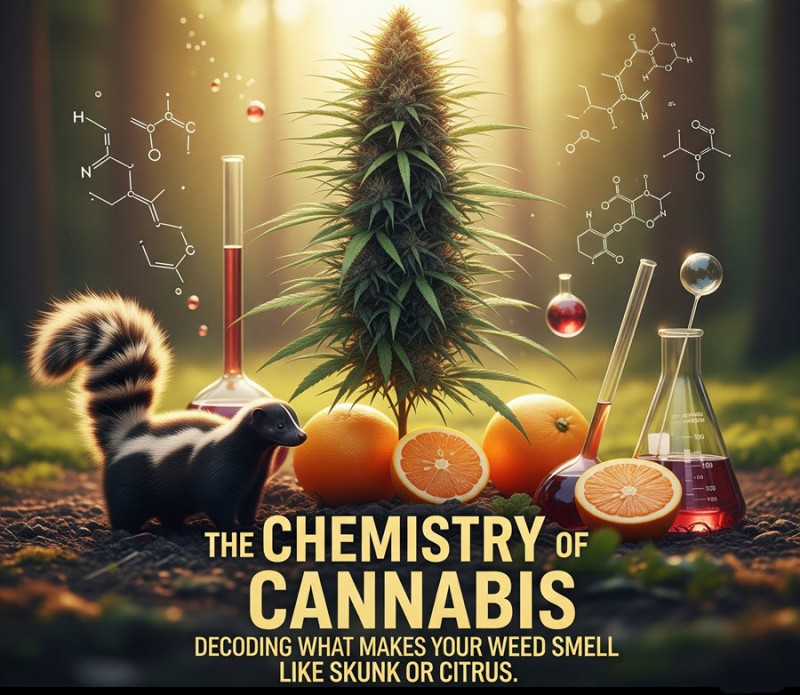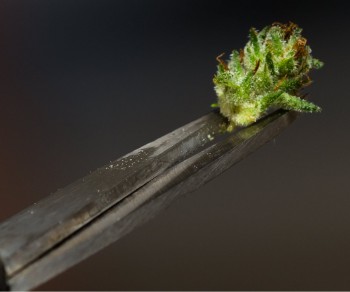
Ever wonder why some cannabis strains smell like a skunk's revenge while others evoke fresh citrus or earthy pine forests? The answer lies in a fascinating molecular symphony that's far more complex than most people realize. A groundbreaking new scientific review has peeled back the curtain on cannabis aromatics, revealing that the distinctive smells and flavors we associate with different strains result from an intricate dance between genetics, cultivation methods, and environmental factors.
For decades, the cannabis community has focused primarily on terpenes - those aromatic compounds that give strains their signature scents. But this new research challenges that conventional wisdom, revealing that cannabis aromatics involve a much broader cast of molecular characters. We're talking about terpenes, yes, but also flavonoids, phenols, aldehydes, ketones, esters, and sulfur-containing compounds all working together to create the complex sensory profiles that make each strain unique.
This isn't just academic curiosity - understanding these molecular mechanisms has profound implications for the future of cannabis cultivation and product development. We're potentially looking at a future where breeders can engineer strains with precisely targeted aromatic and therapeutic profiles, where cultivators can manipulate environmental conditions to maximize specific compound production, and where consumers can choose products based on scientifically-backed flavor wheels rather than guesswork and marketing hype.
The research, conducted by scientists in Switzerland, Germany, and Spain, represents the kind of rigorous scientific investigation that the cannabis industry desperately needs as it matures from underground culture to legitimate agriculture. By mapping the molecular foundations of cannabis aromatics, we're laying the groundwork for a more sophisticated, predictable, and effective approach to cannabis breeding and cultivation.
But here's where it gets really interesting: these aromatic skunk compounds aren't just about smell and taste - they're intimately connected to the therapeutic and psychoactive effects that different strains produce. Understanding how to manipulate these molecular profiles could unlock unprecedented control over cannabis effects, potentially leading to strains designed for specific medical conditions or recreational experiences.
The Molecular Orchestra: Beyond Terpenes
Let's break down the science before we explore what it means for your future smoking experience. Traditional cannabis wisdom has focused heavily on terpenes - organic compounds produced by many plants that contribute to their aroma and flavor. Think of myrcene (that musky, earthy smell), limonene (citrus notes), or pinene (pine forest vibes). These terpenes have been the primary focus of breeding programs and consumer education for years.
But this new research reveals that terpenes are just the lead singers in a much larger molecular choir. The scientists identified several other classes of compounds that contribute significantly to cannabis aromatics:
Flavonoids are compounds that contribute to plant pigmentation and flavor. In cannabis, they add subtle complexity to the overall aromatic profile while potentially offering therapeutic benefits. Think of them as the background vocals that add depth and richness to the overall sensory experience.
Phenols are aromatic compounds that can contribute everything from smoky, medicinal notes to sweet, vanilla-like flavors. These molecules often interact with other compounds to create entirely new aromatic expressions.
Aldehydes and ketones are organic compounds that can contribute fresh, green notes or more complex, fermented flavors depending on their specific structure and concentration. These compounds are particularly interesting because they can change dramatically during curing and storage.
Esters typically contribute fruity, sweet, or floral notes and are often responsible for the more pleasant, dessert-like flavors found in certain strains. They're also highly volatile, meaning they can be easily lost during processing if not handled properly.
Sulfur-containing compounds might sound unpleasant, but they're responsible for some of the most distinctive cannabis aromas, including the infamous "skunk" smell that gives certain strains their name. These compounds are often present in very small quantities but have enormous aromatic impact.
Now, here's the crucial part for non-scientists: imagine cannabis aroma like a symphony orchestra. Terpenes might be the string section - prominent and important - but you also need brass (flavonoids), woodwinds (phenols), percussion (aldehydes and ketones), and even occasional special instruments (sulfur compounds) to create the full, complex musical experience. Remove any section, and the symphony sounds incomplete.
This molecular complexity explains why different cultivation methods, harvesting techniques, and storage conditions can dramatically alter a strain's aromatic profile even when starting with genetically identical plants. Each class of compounds responds differently to environmental stresses, light exposure, temperature changes, and time.
Genetics vs. Environment: The Nature vs. Nurture of Cannabis Aromatics
One of the most important findings from this research is how genetic potential interacts with environmental conditions to determine final aromatic profiles. This has massive implications for both commercial cultivation and home growers trying to maximize their plants' sensory qualities.
Genetic Foundation: Every cannabis plant starts with a genetic blueprint that determines its potential for producing specific aromatic compounds. Think of this like genetic ceiling - a plant can't produce compounds it doesn't have the genetic machinery to synthesize. This is why breeding programs focusing on aromatic traits are so important for developing new strains with novel sensory profiles.
However, having the genetic potential doesn't guarantee expression. This is where environmental factors become crucial:
Light Wavelength and Intensity: Different light spectrums can trigger production of different aromatic compounds. UV light, in particular, can significantly boost terpene production but can also cause degradation if exposure is excessive. LED grow lights that allow precise spectrum control give cultivators unprecedented ability to influence aromatic development.
Soil Composition and Nutrients: The research revealed that specific soil nutrients can dramatically affect terpene levels. Phosphorus, potassium, and trace minerals all play roles in aromatic compound synthesis. This explains why the same strain grown in different soils can have markedly different aromatic profiles.
Water Stress: Controlled water stress during specific growth phases can actually boost production of certain aromatic compounds as the plant responds to environmental pressure. This technique, called "drought stress," is becoming increasingly popular among craft cultivators.
Temperature Fluctuations: Day/night temperature differentials can influence aromatic compound production, with moderate stress often leading to enhanced terpene synthesis.
For commercial operations, this research provides a roadmap for optimizing cultivation protocols to maximize specific aromatic traits. Instead of just focusing on yield and cannabinoid content, cultivators can now manipulate environmental conditions to enhance specific sensory qualities that consumers value.
For home growers, understanding these principles means you can potentially improve your plants' aromatic qualities through relatively simple environmental modifications - adjusting light schedules, fine-tuning nutrients, or implementing controlled stress techniques.
Preservation and Processing: Protecting Molecular Complexity
One of the most practical aspects of this research involves understanding how aromatic compounds degrade and how to prevent that degradation. Many of the molecules responsible for cannabis's distinctive smells and flavors are surprisingly fragile, easily destroyed by heat, light, oxygen, and time.
Heat Degradation: This is why smoking and vaporizing at different temperatures produce different aromatic experiences. Many delicate aromatic compounds are destroyed at high temperatures, which is why low-temperature vaporizing often provides more complex flavor profiles than high-temperature smoking.
Light Exposure: UV and visible light can trigger photochemical reactions that break down aromatic compounds and create undesirable byproducts. The research specifically mentions how limonene (responsible for citrus notes) can oxidize under UV exposure to produce different compounds with altered aromatic properties.
Oxygen Exposure: Oxidation is one of the primary enemies of aromatic preservation. Many terpenes and other volatile compounds readily react with oxygen, creating new compounds that can smell harsh, medicinal, or simply "off."
Humidity Control: Too much moisture can promote mold growth and compound degradation, while too little can cause volatile compounds to evaporate and be lost entirely.
The research suggests several advanced preservation strategies that could revolutionize how cannabis products are stored and packaged:
Vacuum Packaging: Removing oxygen from packaging can dramatically slow degradation of aromatic compounds.
Microencapsulation and Nanoencapsulation: These cutting-edge techniques involve embedding aromatic compounds in protective carriers that release them only when consumed. This could potentially preserve complex aromatic profiles for extended periods.
Controlled Atmosphere Storage: Using specific gas mixtures instead of regular air for storage can optimize preservation of different compound classes.
Freeze-Drying: This technique can preserve aromatic compounds that would be lost during traditional drying methods.
For consumers, this research explains why proper storage is so crucial for maintaining cannabis quality. That jar of flower sitting in sunlight on your windowsill is losing aromatic compounds daily, fundamentally changing its sensory and potentially therapeutic properties.
The Future of Designer Cannabis
Perhaps the most exciting implications of this research involve the potential for creating truly "designer" cannabis strains with precisely targeted aromatic and effect profiles. We're potentially looking at a future where cannabis breeding becomes as sophisticated as wine-making or perfume creation.
Flavor Wheels and Standardization: The researchers call for developing comprehensive cannabis flavor wheels similar to those used in wine, coffee, and tea industries. This would provide standardized language for describing cannabis aromatics and help consumers make more informed choices based on their preferences.
Computational Modeling: The research mentions using "computational modeling" to optimize aromatic profiles. This could involve using artificial intelligence to predict how different genetic modifications and environmental conditions would affect final aromatic outcomes.
Synthetic Biology: Advanced genetic engineering techniques could potentially allow breeders to introduce entirely new aromatic pathways into cannabis, creating strains with novel sensory profiles impossible to achieve through traditional breeding.
Targeted Effects: Understanding the relationship between aromatic compounds and therapeutic effects could enable development of strains designed for specific medical conditions or recreational experiences.
However, the research also notes important limitations. Creating truly standardized aromatic profiles is challenging because cannabis aromatics are so complex and influenced by so many variables. A comprehensive flavor wheel would require "extensive study encompassing various strains, trained sensory panelists, and detailed metabolomic analysis."
The scientists also emphasize that breeding for aromatic traits can't ignore agricultural performance. There's "increasing evidence that these traits are intertwined with plant stress responses and overall cultivation performance." This means that optimizing for specific flavors might require trade-offs in yield, pest resistance, or other practically important characteristics.
The Sticky Bottom Line: A More Sophisticated Cannabis Future
This research represents exactly the kind of scientific rigor that the cannabis industry needs as it transitions from underground culture to legitimate agriculture and medicine. By understanding the molecular foundations of cannabis aromatics, we're laying the groundwork for a more sophisticated, predictable, and effective approach to cultivation and product development.
For cultivators, this research provides actionable insights into how genetic selection, environmental optimization, and post-harvest handling can be combined to maximize aromatic qualities. Instead of relying on trial and error, growers can now apply scientific principles to enhance specific sensory characteristics that consumers value.
For consumers, this research promises a future where cannabis products are more consistent, more precisely targeted to individual preferences, and backed by scientific understanding rather than marketing hype. Imagine being able to choose strains based on scientifically-validated flavor wheels that predict not just taste and smell, but likely effects and therapeutic benefits.
For the broader cannabis industry, this type of research legitimizes cannabis as a serious agricultural and pharmaceutical product worthy of the same scientific attention given to other valuable crops. As the researchers note, "continued collaboration between researchers and industry stakeholders" is essential for unlocking cannabis's full potential.
The complexity revealed by this research also highlights why cannabis prohibition has been so counterproductive. We've lost decades of potential scientific progress due to political restrictions on research. Now that we're finally able to study cannabis properly, we're discovering that it's far more sophisticated and potentially valuable than even advocates realized.
Moving forward, the cannabis industry needs to embrace this scientific approach while preserving the innovation and diversity that characterized the underground era. The goal isn't to replace craft cannabis culture with corporate standardization, but to enhance traditional knowledge with scientific understanding.
The molecular symphony that creates cannabis aromatics is incredibly complex, but understanding it opens up unprecedented possibilities for improving both the sensory experience and therapeutic potential of this remarkable plant. We're just beginning to unlock cannabis's secrets, and the future looks both aromatic and promising.






